“If you have these two things – the willingness to change, and the acceptance of everything as it comes, you will have all you need to work with.”
–Charlotte Selver
“Don’t stop the line.” For many years this was an agreement, almost an unwritten law, of the General Motors assembly lines building cars and trucks. Management believed that keeping the car assembly line going at all times was essential keeping the line going was clearly more efficient than stopping. According to a 30-year GM employee, management assumed that “If the line stopped, workers would play cards or goof off.” The result of this philosophy and way of working? Problems were ignored instead of addressed. Defective cars, some missing parts, or cars with parts put on backwards, were put into their own special “defective” lot. This lot grew to enormous proportions. At some point, addressing and fixing these problem cars became too costly.
That same year, a group of General Motors assembly workers were sent to Fremont, California, as part of a GM/Toyota collaboration called NUMMI (New United Motor Manufacturing, Inc.). Several GM managers were flown to Japan to learn the Japanese methodology for building cars. What they discovered – was an amazing aha! Anyone on the assembly line who had a concern about the quality of a part could stop the line at any time. They witnessed firsthand how groups of workers got together to address and solve problems. Toyota managers assumed that their workers wanted to build the best cars possible that facing problems immediately might have short-term negative consequences but substantial benefits over the long-term.
At Toyota, constant improvement was a regular motto and attitude, and was regularly integrated within all aspects of car production. Teams were assembled to discuss problems, look for insights, and develop better methods for producing problem-free cars. Toyota consistently built better quality cars with more efficiency and lower costs.
In my speaking, coaching and consulting practice, I notice many versions of “don’t stop the line.” It might take the form of “don’t question the boss” or “don’t confront the rude but star salesperson.” It can also come in the guise of spending more time projecting and planning with old and out-dated habits and assumptions, instead of cultivating (somewhat uncomfortable) strategic and critical thinking. There are many other subtle and not so subtle behaviors and habits of overlooking and avoiding problems in the world of work. Stopping, admitting mistakes, working collaboratively and improving processes that are for the good of the organization, require courage and often require asking difficult questions.
It is easy to look at GM and see their folly, and this particular GM tale is a well-known story in today’s organizational effectiveness lore. But what about your company or
organization? And more broadly, what about your life?
Ask yourself:
What version of “don’t stop the line” is embedded in your organization, relationships and life?
What might stopping look like?
How might your work and life benefit from stopping and pausing? What are the risks?

